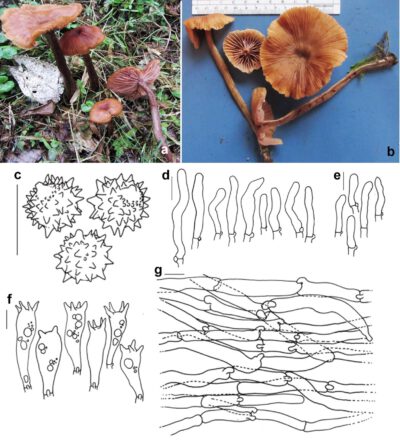Fungalpedia – Note 201, Laccaria
Laccaria Berk. & Broome
Citation if using this entry: Bera et al. 2024 (in prep) – Fungalpedia, Basidiomycota 1.
Index Fungorum, MycoBank, Facesoffungi, GenBank, Fig. 1
Classification: Hydnangiaceae, Agaricales, Agaricomycetes, Basidiomycota, Fungi.
Laccaria is a cosmopolitan and species-rich genus of the Agaricales. The distribution of the members of this genus has mostly been recorded from tropical to temperate areas (Mueller 1992, Kropp & Mueller 1999, Osmundson et al. 2005, Wilson et al. 2013, Popa et al. 2014), forming an ectomycorrhizal association with Betulaceae, Fagaceae, Myrtaceae, Pinaceae, and Salicaceae (Cho et al. 2018). Laccaria species are frequently employed as experimental models for researching ectomycorrhizal basidiomycetes due to their capacity for vegetative growth and germination from basidiospores in controlled environments (Podila et al. 2002). Particularly two species of Laccaria, namely L. bicolor (Maire) P.D. Orton and L. amethystina Cooke serve as representative organisms for investigating the genetic makeup and life cycle of ectomycorrhizal fungi (Bastide et al. 1995, Martin et al. 2008, Vincenot et al. 2012, Kohler et al. 2015, Cho et al. 2018). Morphologically, Laccaria can be characterized by its basidiomata of purple, orange, or brown colour tones and the typical globose to oblong, multinucleate basidiospores with echinulate ornamentation (Berkeley & Broome 1883, Singer 1986, Mueller 1992, Cho et al. 2018). However, according to Mueller (1992), a set of characters such as the colour of the basidiomata, size, shape of basidiospores, and sterigmata number per mature basidia can delimit the species but it is not ideally accepted as the sole way for identification because of the probability of similar characters (Sheedy et al. 2013, Cho et al. 2018).
With the introduction of the nrITS marker, the precision of species identification within Laccaria was enhanced with the discovery of many new species (Wilson et al. 2013, Popa et al. 2014, 2016). Yet, with more discovery of taxa within the genus, nrITS was proven to have limited utility to delimit the closely related species (Wilson et al. 2017). Sheedy et al. (2013) in their study of Australian Laccaria species revealed that the usage of other genetic markers like rpb2 and tef1 has shown significantly better results in the resolution of species (Cho et al. 2018). Currently, the multigene (nrITS, nrLSU, rpb2, and tef1) approach with morphological characterization is the key to identifying the Laccaria species (Wilson et al. 2017, Cho et al. 2018). A more recent development involved the complete sequencing of the L. bicolor genome (Martin et al. 2008), enabling the identification of the genetic makeup responsible for rhizosphere colonization and symbiosis (Montoya et al. 2015). To date, approximately 92 species of Laccaria have been documented worldwide (Species Fungorum 2023).
Synonyms: Russuliopsis J. Schröt.
Type species: Laccaria laccata (Scop.) Cooke
Other accepted species: (Species Fungorum – search Laccaria)
Figure 1 – Laccaria indohimalayana (holotype KD 17-20). a & b Basidiomata. c Basidiospores. d Sterile elements on face of the lamellae. e Sterile elements on edge of lamellae. f Basidia. g Hyphal elements in pileipellis. Scale bars: c-g =10 μm. Taken from Wang et al. (2019).
References
Entry by
Ishika Bera, Center of Excellence in Fungal Research, Mae Fah Luang University, Chiang Rai 57100, Thailand
(Edited by Kevin D Hyde, Samaneh Chaharmiri-Dokhaharani, & Achala R. Rathnayaka)
